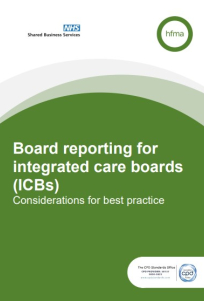Different finance team models emerge across ICBs
A briefing from the HFMA, informed by a roundtable held over the summer, said that distinct finance team models were being adopted across the 42 ICBs, which began operating in July. These differences are often driven by board size and the number of predecessor commissioners that have merged as part of the move to system working.
ICBs have faced a number of challenges in developing finance teams. The speed of implementation of the new structure combined with the employment guarantee for staff in predecessor organisations has restricted the opportunities to make significant changes. And there were also immediate demands placed on teams – both in setting up the new boards and closing down old organisations.
There are also new roles to get comfortable with. For example, ICBs will not only report on their own performance, but review performance across the system. The briefing – Developing an effective ICB finance team – identifies three models that have emerged in the first months of ICB operation. Some boards are developing a business partnering model to work with place-based collaboratives. The briefing says that this recognises ‘the need to understand the population to enable service transformation, working with different partners at a local level’.
An alternative model sees each member of the finance team aligned with both a place and a functional responsibility such as mental health or urgent care. This enables staff to have both a place and a system view and has the benefit of building resilience with multiple staff linked to each function.
A third option involves structuring the finance team to reflect patient pathways. In this set-up, finance staff can look across all organisations in a patient journey.
‘The options available to a board may be dictated by the size of team inherited from the legacy clinical commissioning groups,’ said Sarah Day (pictured), HFMA senior policy manager. ‘If a number of CCGs have come together to form the board, there is potentially more scope to provide finance resource in a number of ways and support multiple approaches,’ she said, adding that the models described were not mutually exclusive. ‘But smaller ICBs could have more elements to support than the finance team is able to service.’
A balance needed to be found between taking time to consider the most appropriate model and waiting too long, which might entrench traditional ways of working. However, the briefing suggested that the way the ICB looked and operated in year one would be quite different to the model in year three.
While commissioning finance staff will have brought many relevant skills into the new boards, they would also need to develop new competencies. A good example is capital planning. While capital planning has long been the preserve on NHS provider finance teams, ICBs are now responsible for overseeing the system capital plan and supporting the prioritisation of capital spending. ICBs are also likely to have a role in conflict resolution, sorting out disagreements between organisations across the system.
In Board reporting for ICBs: considerations for best practice – a separate briefing from the HFMA supported by NHS Shared Business Services – the association explores how financial reporting could look both for the ICB itself and for the wider system.
While the ICB report should follow best practice for financial reporting for any entity, the briefing says that a decision will need to be made whether to report the financial position as a whole or by place. Even if place-based reporting is due to introduced later, the required information should be considered upfront to ensure it can be collected when needed.
For the wider system, the ICB will need to report the system financial position to demonstrate the system is delivering, or on target to deliver, financial balance. Inevitably this will focus on the bottom-line position of organisations in the system – with the overall position being the sum of individual surpluses and deficits.
But to understand where costs are being incurred, reports could also include analysis of expenditure by type, service line, population health segment or programme cost. Balance sheet metrics such as debtor days, creditor days and liquidity ratio will also help the ICB and partner bodies understand the full financial picture.
A further example of best practice would be include a breakdown of cost data across the system by population segments. Initially this may have to focus on secondary healthcare costs, recognising the lack of robust cost data across primary care. Financial reports should also increasingly link financial data to health inequalities and population health data.
Related content
The Institute’s annual costing conference provides the NHS with the latest developments and guidance in NHS costing.
The value masterclass shares examples of organisations and systems that have pursued a value-driven approach and the results they have achieved.